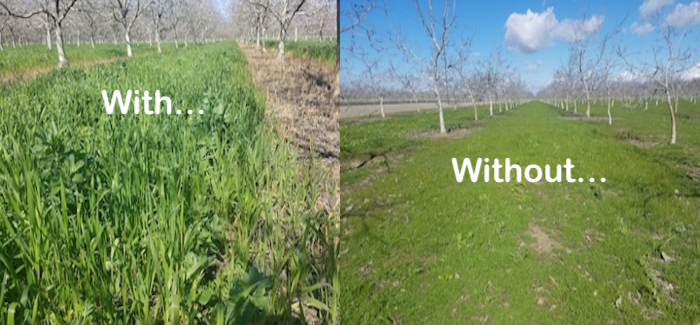COVER CROPS NEED NITROGEN
DILEMMA: How do growers compensate for the lack of nitrogen when planting a cover crop without compost? And, why do some walnut orchard soils that are very similar and with the same compost application rates exhibit differing Potash and or Phosphorous levels?
Numerous walnut growers have been “cover cropping” with 4 tons of compost for the last 7 or 8 years. This is done as soon after harvest as possible. The nutrients in the compost supply the necessary fertilizer needed for adequate growth. The picture on the left above shows this growth.
Recently, it has been discovered thru the Albrecht soil test that some fields following this program exhibit excess levels of Potash and or Phosphorous. The negative aspects of these excesses will be discussed in a following post. The real take away is that when this situation occurs, that some other source of nutrients is required to attain satisfactory growth, especially Nitrogen, which is the most obvious when deficient. The picture above on the right shows the results when no compost is applied at cover crop planting.
The obvious solution is to back off from the high rates of compost and to continue with the Albrecht soil test. For those starting on a healthy soil quest, 2 tons of compost plus 500 pounds of Humified Protein would be a good middle ground to start. Humified Protein and Soil Grow are the same product and is discussed in a prior post.
This rate would re inoculate biology after a year of normal crop production, where virtually every synthetic input is harmful to soil biology. This application should also provide sufficient nutrients needed for the cover crop.
For those with the described excesses, 500 pounds of compost plus 500 pounds of Humfied Protein is our recommendation. The compost is to provide sufficient carrier for spreading. Nitrogen may be a limiting nutrient and some ammonium sulfate may be required, 100 t0 200 pounds.
We are not sure exactly what is happening as the studied fields are the same soil type, a Zamora silt loam, located on both sides of the Sacramento River. So, soils that are lighter in texture could arrive at this excess situation much sooner. What is known is that continued, high rates of compost without adequate Albrecht soil testing is not advised.
Reference Material:
Kinsey Ag Services
Call Us Today to Learn More of how Quality Compost and Soil Grow
Can Benefit your Orchard, Row Crop Operation or Garden
530-521-1616


Leave a Reply